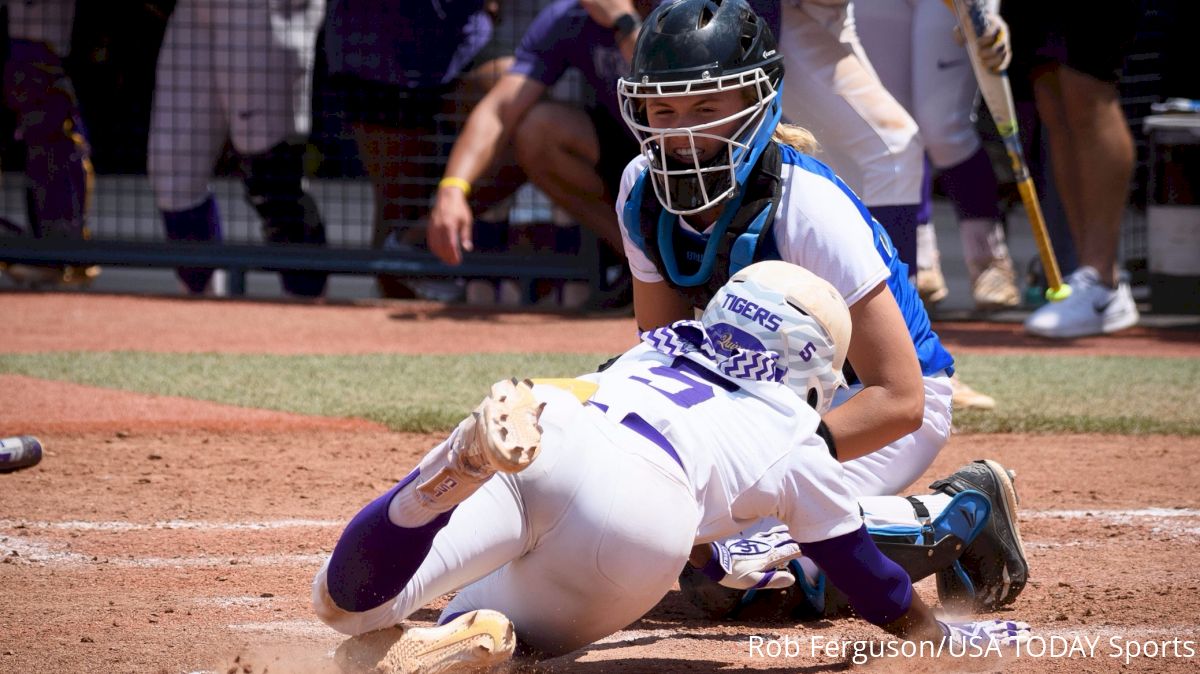Softball Panel Approves Changes To NCAA Obstruction Rule
Softball Panel Approves Changes To NCAA Obstruction Rule
Softball panel approves changes to NCAA obstruction rule.

Last season, college softball saw a plethora of controversial obstruction calls that changed the outcome of several critical games in the postseason. The Women's College World Series magnified this issue when UCLA lost a 2-1 opening matchup to LSU after Bruins catcher Paige Halstead was called for obstruction and the Tigers were awarded the game-winning run.
In an 8-2 elimination game win over Texas A&M, UCLA got burned again when the Bruins' Gabrielle Maurice collided with Aggies catcher Ashley Walters in a play at home plate. Walters was in Maurice's path when she received the throw to home and tagged the baserunner on the helmet. However, no call was made.
See the play at 1:20 in the below video:
[tweet url="https://twitter.com/NCAAsoftball/status/870403412336066560" hide_media="0" hide_thread="1"]
The NCAA Softball Rules Committee believes this change is equitable for the base runner and the defensive team. Under the rule, a base runner will have a clear path to the base. Also, if the defender has possession of the ball and is in front of the plate or base, the runner can slide and have contact with the defensive player if the runner is making a legitimate attempt to touch the plate or base.
If a defender blocks the plate or base before gaining possession, the runner will be called safe. If the runner contacts the defensive player without making a legitimate attempt to slide, the runner will be called out.
Currently, the defender could block the plate or base while in the act of catching the ball. The rules committee felt the language was too ambiguous. The rule change clarifies the rule and seeks to remove any gray area for plays of that nature.
The lane will be 3 feet wide and 30 feet long. If a runner is outside the lane and is hit by the ball, and in the judgment of the umpire interferes with the defensive player receiving the ball at first base, the runner will be declared out.
During its 2015 annual meeting, the rules committee voted to eliminate the runner's lane as a required line on the field. However, this change inadvertently and fundamentally changed the concept of the runner's lane.
The committee felt there is a need for the line to help umpires determine whether a runner interfered with a throw to first base, and to give the runner a clear area where she can run without penalty.
When using the media format, teams will be allowed only seven charged conferences per seven-inning game. Each team is allowed one charged conference per half-inning for each extra inning. If a team doesn't use all seven conferences in regulation, they do not carry over into extra innings.
Several Division I conferences experimented with a time limit between innings and restricted number of conferences during the 2017 season.
In an 8-2 elimination game win over Texas A&M, UCLA got burned again when the Bruins' Gabrielle Maurice collided with Aggies catcher Ashley Walters in a play at home plate. Walters was in Maurice's path when she received the throw to home and tagged the baserunner on the helmet. However, no call was made.
See the play at 1:20 in the below video:
[tweet url="https://twitter.com/NCAAsoftball/status/870403412336066560" hide_media="0" hide_thread="1"]
Here is what NCAA released on approved rule changes:
The NCAA Playing Rules Oversight Panel approved a rule banning defenders in softball from blocking the plate or base before they have possession of the ball, effective for the 2018 season.The NCAA Softball Rules Committee believes this change is equitable for the base runner and the defensive team. Under the rule, a base runner will have a clear path to the base. Also, if the defender has possession of the ball and is in front of the plate or base, the runner can slide and have contact with the defensive player if the runner is making a legitimate attempt to touch the plate or base.
If a defender blocks the plate or base before gaining possession, the runner will be called safe. If the runner contacts the defensive player without making a legitimate attempt to slide, the runner will be called out.
Currently, the defender could block the plate or base while in the act of catching the ball. The rules committee felt the language was too ambiguous. The rule change clarifies the rule and seeks to remove any gray area for plays of that nature.
Runner's Lane
The panel approved a rule requiring that the runner's lane be drawn on the field down the first base line, reverting to the rule that was in place in 2014 and 2015.The lane will be 3 feet wide and 30 feet long. If a runner is outside the lane and is hit by the ball, and in the judgment of the umpire interferes with the defensive player receiving the ball at first base, the runner will be declared out.
During its 2015 annual meeting, the rules committee voted to eliminate the runner's lane as a required line on the field. However, this change inadvertently and fundamentally changed the concept of the runner's lane.
The committee felt there is a need for the line to help umpires determine whether a runner interfered with a throw to first base, and to give the runner a clear area where she can run without penalty.
Media Format
The panel approved a two-minute time limit to resume play between each half-inning in televised games.When using the media format, teams will be allowed only seven charged conferences per seven-inning game. Each team is allowed one charged conference per half-inning for each extra inning. If a team doesn't use all seven conferences in regulation, they do not carry over into extra innings.
Several Division I conferences experimented with a time limit between innings and restricted number of conferences during the 2017 season.